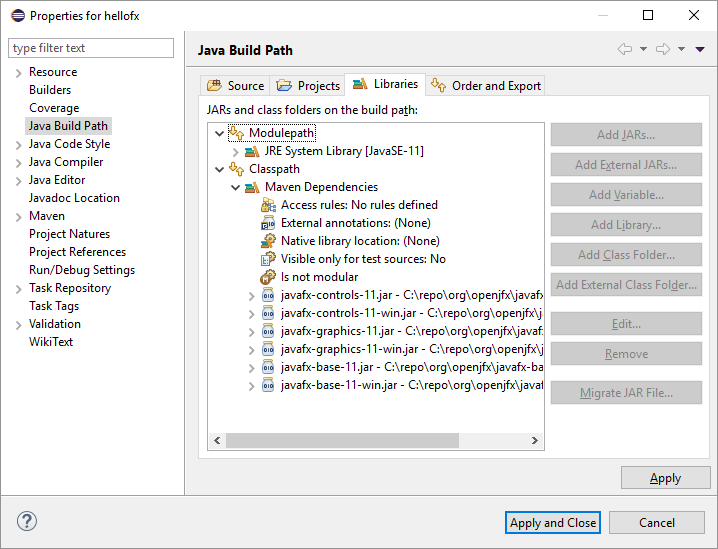I'm starting to dig into Java 11 migration for a large app (includes Java FX parts) and I need your help to understand the difference between Maven (3.5.4) on the command-line and Eclipse (2018-09 with Java11 upgrade).
I have a simple Java 11 class
import java.util.stream.Stream;
import javafx.application.Application;
import javafx.scene.Scene;
import javafx.scene.control.Label;
import javafx.stage.Stage;
public class HelloFX extends Application {
@Override
public void start(Stage stage) {
String javaVersion = System.getProperty("java.version");
String javafxVersion = System.getProperty("javafx.version");
Label l = new Label("Hello, JavaFX " + javafxVersion + ", running on Java " + javaVersion + ".");
Scene scene = new Scene(l, 640, 480);
stage.setScene(scene);
stage.show();
}
public static void main(String[] args) {
Stream.of("jdk.module.path",
"jdk.module.upgrade.path",
"jdk.module.main",
"jdk.module.main.class").forEach(key -> System.out.println(key + " : " + System.getProperty(key)));
Application.launch();
}
}
and a simple pom
<project xsi:schemaLocation="http://maven.apache.org/POM/4.0.0 http://maven.apache.org/maven-v4_0_0.xsd">
<modelVersion>4.0.0</modelVersion>
<groupId>com.gluonhq</groupId>
<artifactId>hellofx</artifactId>
<version>1.0-SNAPSHOT</version>
<dependencies>
<dependency>
<groupId>org.openjfx</groupId>
<artifactId>javafx-controls</artifactId>
<version>11</version>
</dependency>
</dependencies>
<build>
<plugins>
<plugin>
<groupId>org.apache.maven.plugins</groupId>
<artifactId>maven-compiler-plugin</artifactId>
<version>3.8.0</version>
<configuration>
<release>11</release>
</configuration>
</plugin>
<plugin>
<groupId>org.codehaus.mojo</groupId>
<artifactId>exec-maven-plugin</artifactId>
<version>1.2.1</version>
<executions>
<execution>
<goals>
<goal>java</goal>
</goals>
</execution>
</executions>
<configuration>
<mainClass>HelloFX</mainClass>
</configuration>
</plugin>
</plugins>
</build>
</project>
When I run 'mvn compile exec:java' I think nothing uses the new module-path and the program displays the JavaFX panel as expected. The system out is:
jdk.module.path : null
jdk.module.upgrade.path : null
jdk.module.main : null
jdk.module.main.class : null
When ran from an Eclipse launcher, I have to add to the launcher the following vm arguments:
--module-path=${env_var:JAVAFX_PATH} --add-modules=javafx.controls
and the panel is also displayed but the output is:
jdk.module.path : C:\dev\tools\javafx-sdk-11\lib
jdk.module.upgrade.path : null
jdk.module.main : null
jdk.module.main.class : null
jdk.module.main.class : null
I cannot make it work in Eclipse as it works from the command line: I am forced to mess with the modules and module-path. If I do not add the vm parameters, I got either "Error: JavaFX runtime components are missing, and are required to run this application" or "Error occurred during initialization of boot layer java.lang.module.FindException: Module javafx.controls not found".
How can it work form the command-line without any more configuration ? To my knowledge Maven do not add automagically anything to the module path...
Any idea ? What am I missing ?
Update1: I realized that when importing the project in Eclipse "as Maven project" (which is what I always do) it results in the JRE being added in the module path (which is not the case for my classis projects). See the screenshot 
